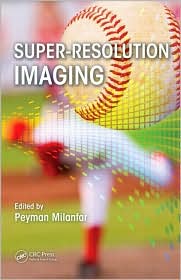|
A volume in the
Digital Imaging and Computer Vision series

Super-Resolution Imaging
Edited by:
Peyman Milanfar
University of California, Santa Cruz, California, USA
Boca Raton, FL, CRC Press / Taylor & Francis, September 2010
ISBN
978-1-4398-1930-2
Audience:
 |
Academic community (graduate student, post-doc and
faculty) in Electrical Engineering, Computer Science, and Applied
Mathematics |
 |
Industrial community (engineers,
engineering managers, research lab staff and managers) |
|
|
With the exponential increase in
computing power and broad proliferation of digital cameras,
super-resolution imaging is poised to become the next "killer app." The
growing interest in this technology has manifested itself in an
explosion of literature on the subject. Super-Resolution Imaging
consolidates key recent research contributions from eminent scholars and
practitioners in this area and serves as a starting point for
exploration into the state of the art in the field. It describes the
latest in both theoretical and practical aspects of direct relevance to
academia and industry, providing a base of understanding for future
progress.
Recent advances in camera sensor
technology have led to an increasingly larger number of pixels being
crammed into ever-smaller spaces. This has resulted in an overall
decline in the visual quality of recorded content, necessitating
improvement of images through the use of post-processing. Providing a
snapshot of the cutting edge in super-resolution imaging, this book
focuses on methods and techniques to improve images and video beyond the
capabilities of the sensors that acquired them. It covers:
 | History and future directions of super-resolution
imaging |
 |
Locally adaptive processing methods
versus globally optimal methods |
 |
Modern techniques for motion
estimation |
 |
How to integrate robustness |
 |
Bayesian statistical approaches |
 |
Learning-based methods |
 |
Applications in remote sensing and
medicine |
 |
Practical implementations and
commercial products based on super-resolution |
The book concludes by concentrating on
multidisciplinary applications of super-resolution for a variety of
fields. It covers a wide range of super-resolution imaging
implementation techniques, including variational, feature-based,
multi-channel, learning-based, locally adaptive, and nonparametric
methods. This versatile book can be used as the basis for short courses
for engineers and scientists, or as part of graduate-level courses in
image processing.
Features:
 |
Presents a comprehensive overview of
the field, surveying the latest techniques in super-resolution imaging
|
 |
Provides detailed coverage of
implementations and applications |
 |
Contains numerous examples,
illustrations, tables and figures |
 |
Explores new digital image and video
processing applications |
 |
Features top contributors from USA,
UK, Israel, Japan, and the European Union |
|
